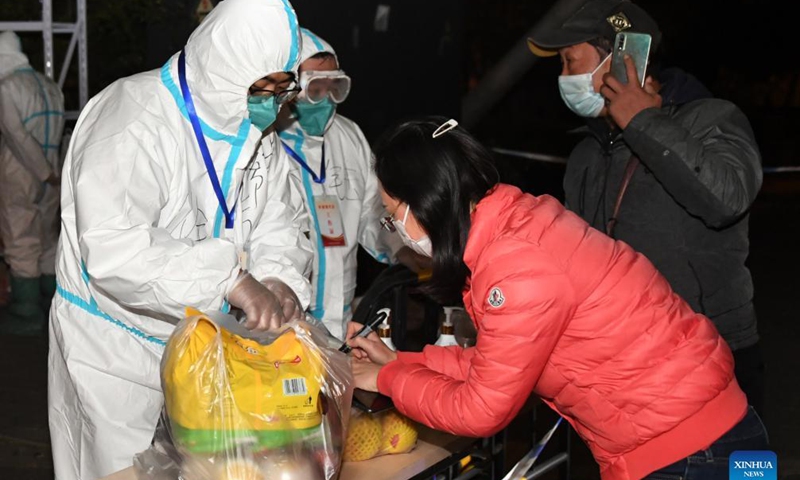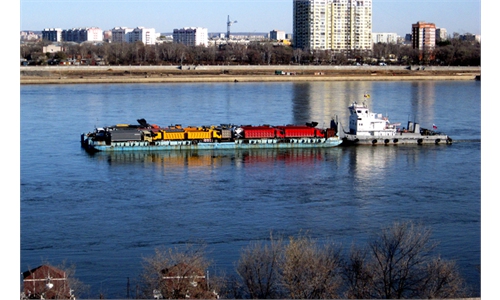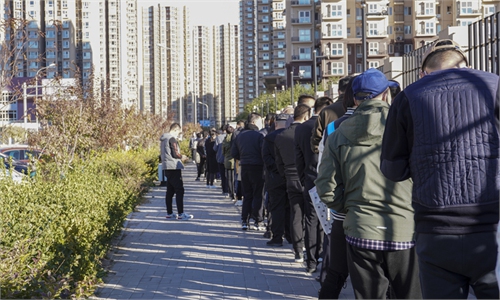Border cities put under lockdown, penalties more stringent amid new COVID-19 spike
New round more complex than previous times, ‘sounds alarm’ for slack awareness

Staff members receive supplies at Furongli residential community in Haidian District in Beijing, capital of China, Oct. 26, 2021. Furongli has been put under closed-off management after one confirmed case of COVID-19 in the community on Oct. 24.
As the new wave of COVID-19 continues to ravage the nation with more than 300 confirmed local cases registered by Thursday, China has rolled out anti-epidemic measures that are being imposed more promptly and stringently than previous moves, putting at least three cities in lockdown and implementing stricter penalties for people obstructing related work.
The latest surge doesn't yet compare to the last round, which started from Nanjing in July, either in terms of the number of infections or regions. But experts noted that the situation is even more complex this time, as cases are more scattered across the country, posing more challenges.
Heihe in Northeast China's Heilongjiang Province, a major port city bordering Russia, has become the latest lockdown point, following the China-Mongolia border city Ejin Banner and Northwest China's transport hub Lanzhou.
It ordered that starting from Thursday, all units in the city are to suspend operation and production except for departments essential to residents' daily lives. Residential communities and villages will also be closed off.
The lockdown comes after the city reported one confirmed COVID-19 case and three asymptomatic cases on Wednesday, the first to be found in Heilongjiang in the new round of COVID-19 outbreaks, not long after the province experienced a viral spike in late September.
Wang Peiyu, a deputy head of Peking University's School of Public Health, told the Global Times on Thursday that implementing the strictest lockdown policy is better for epidemic control, but it comes at a higher cost for suspending work and production. However, as Heihe has a relatively small population compared with other border cities and faces a tougher challenge of imported COVID-19 cases as winter comes, the overall consideration would be to put epidemic prevention as the top priority.
Under pressure to flatten the COVID-19 curve before Beijing welcomes the Winter Olympic Games, the capital city, which reported 27 locally transmitted cases in the latest outbreak as of Thursday, has rolled out stringent anti-epidemic examinations and penalties rarely seen in previous rounds.
Two men were the subject of a criminal case filed by police after organizing 53 residents from Beijing on a one-day bus tour to neighboring Hebei Province on October 19. The organizer and the bus driver did not check health codes for each tourist, and one of them who had a travel history to high-risk areas tested positive for COVID-19, Beijing authorities revealed on Wednesday.
So far, Beijing police have handled 24 cases of epidemic-related crimes that obstructed epidemic prevention work, with 19 criminal cases being investigated and 13 given administrative penalties.
The Ministry of Transport announced on Thursday a halt to all cross-city bus, taxi, ride-hailing activities, as well as all outbound customer services for all medium- and high-risk regions.
The Ministry of Culture and Tourism issued a notice earlier this week, seeking the implementation of a freeze for all travel activities in medium- and high-risk regions.
Since October 17, more than 300 local confirmed COVID-19 cases have been registered in 12 provincial-level regions, with about half being found in Ejin Banner.
Experts believe that the Ceke Port of Ejin Banner is the most likely source of the virus through personnel and goods exchanges with the neighboring country of Mongolia.
Compared with a previous resurgence centering around the Nanjing airport, which was at that time the worst since the initial outbreak in Wuhan, Hubei Province, transmission of the latest surge has involved fewer cases and regions so far, in terms of numbers.
However, Wang said that the latest surge is even more complex as infections are more dispersed in scattered places, while the last outbreak was more clustered.
The expert explained that it is because the hidden virus got spread widely when tourists across the country came flooding into Ejin for visits during the golden travel month of October, which is evident because most cases were found to have been related to tour groups that visited to the city.
Wang added that the stricter measures carried out this time also serve as a "wake-up call" to the public, which has been paying less attention to self-protection in recent days, when no severe cluster infections were reported in China.
Given the mature emergency response mechanism in China, such a viral spike can normally be curbed in about a month, Wang said.


